Research on Spatial Delineation Method of Urban-Rural Fringe Combining POI and Nighttime Light Data—Taking Wuhan City as an Example
Abstract
:1. Introduction
2. Overview of the Study Area and Data Processing
2.1. Overview of the Study Area
2.2. Data Source and Preprocessing
2.2.1. Data and Sources
2.2.2. Data Preprocessing
3. Research Design
3.1. Research Methods
3.1.1. Kernel Density Estimate (KDE)
3.1.2. NPP and POI Composite Index
3.1.3. Breaking Point Analysis
3.1.4. Land Use Structure Information Entropy Model
3.2. Standards for Spatial Delineation of Urban-Rural Fringe
3.2.1. NPP and POI Composite Index Construction
3.2.2. Analysis of the Relationship between NPP and POI and Urban and Rural Spatial Structure
3.3. Delineation of Test Methods for Results
4. Results
4.1. Identification Results of Inner Boundary of Urban-Rural Fringe
4.2. Delineation of Spatial Scope of Urban-Rural Fringe
5. Discussion
5.1. Verification of Urban-Rural Fringe Identification Results
5.1.1. Overall Space Measurement
5.1.2. Transects Verification
5.1.3. Field Verification
5.2. Spatial Analysis of Urban and Rural Fringe in Wuhan
5.3. Comparative Analysis
5.4. Limitations
6. Conclusions
- (1)
- NPP and POI composite index is applied to the study of spatial delineation of urban-rural fringe, which can not only give full play to the attributes and micro-advantage potential of POI, synthesize the difference between the type of facilities and light intensity, reduce the “saturation” and “overflow” effects of Nighttime Light, but also master the direction of urban and rural development in a large scale by using NTL, reduce broken and isolated spots, and ensure the continuity of identification results. Compared with using POI, NTL, or population density data alone, the accuracy is higher, and the timeliness is more efficient.
- (2)
- NPP and POI can quantitatively identify potential central area and multi-layer structure of the city. The urban-rural fringe area of Wuhan is 1482.35 km2, which accounts for 17.30% of the total area of Wuhan City. Around the main body of the urban core area, it presents the “six axes and two rings” banded and leaping distribution characteristics. The urban core area of Wuhan City is in the form of “one main area with multiple cores”, and the rural areas are widely distributed in the periphery of Wuhan City, presenting a continuous distribution feature. This characteristic shows that NPP and POI can better represent the vitality of urban development than population statistics, land use, and landscape. The identification results have important reference significance for the allocation of global urban infrastructure, industrial division, ecological function division, and other studies.
- (3)
- NPP and POI composite index shows a double mutation law in urban and rural spaces. The first mutation occurred between the urban core area and the URF. With the increasing distance from the urban core area, NPP and POI showed a rapid downward trend. The second mutation occurred between the URF and the rural. With the increasing distance from the URF, the cumulative value of NPP and POI isosurface area showed a sharp upward trend. This law confirms that the urban-rural fringe, as a regional entity generated in the process of urban expansion, objectively exists, has spatial continuity, transition of factors such as economy, population, and land, and consistency of internal characteristics, which is of empirical significance for the discussion of the ternary and binary models in the study of cities spatial structure.
- (4)
- This paper only takes Wuhan City as an example to discuss the urban and rural spatial change law of NPP and POI and delimit the spatial scope of its urban-rural fringe. After the data are enriched in the future, cities with different areas, populations, and economic development statuses can be compared and analyzed to discuss the universality. Although NPP and POI can distinguish between natural landscape and man-made landscape, its value is extremely low in agricultural land, ecological land, and other natural areas, and the spatial subordination of such areas needs to be further discussed. NPP and POI can represent the vitality of development, with convenient access and a short renewal cycle. If machine learning and other methods can be used to build the spatial range of URF at different time points, it is of great significance to analyze the speed and direction of global urban expansion, urban shrinkage, and other issues.
Author Contributions
Funding
Institutional Review Board Statement
Informed Consent Statement
Data Availability Statement
Conflicts of Interest
References
- Zeng, J.; Cui, X.; Chen, W.; Yao, X. Impact of urban expansion on the supply-demand balance of ecosystem services: An analysis of prefecture-level cities in China. Environ. Impact Assess. Rev. 2023, 99, 107003. [Google Scholar] [CrossRef]
- Zeng, T.; Jin, H.; Geng, Z.; Kang, Z.; Zhang, Z. Urban-Rural Fringe Long-Term Sequence Monitoring Based on a Comparative Study on DMSP-OLS and NPP-VIIRS Nighttime Light Data: A Case Study of Shenyang, China. Int. J. Environ. Res. Public Health 2022, 19, 11835. [Google Scholar] [CrossRef] [PubMed]
- Zhong, S.; Wang, M.; Zhu, Y.; Chen, Z.; Huang, X. Urban expansion and the urban–rural income gap: Empirical evidence from China. Cities 2022, 129, 103831. [Google Scholar] [CrossRef]
- Bryant, C.; Russwurm, L.H.J.P.C. The impact of non-farm development on agriculture—A synthesis. Plan Can. 1979, 19, 122–139. [Google Scholar]
- Gu, C.L.; Chen, T.; Ding, J.H.; Yu, W. The Study of The Urban Fringes in Chinese Megalopolises. Acta Geogr. Sin. 1993, 48, 317–328. [Google Scholar] [CrossRef]
- Sharp, J.S.; Clark, J.K. Between the Country and the Concrete: Rediscovering the Rural-Urban Fringe. City Community 2010, 7, 61–79. [Google Scholar] [CrossRef]
- Zhang, J.M. Review and Perspective of the Studies on Rural Urban Fringe. Hum. Geogr. 1997, 12, 5–8. [Google Scholar]
- Huang, J.; Zhou, Q.; Wu, Z. Delineating Urban Fringe Area by Land Cover Information Entropy—An Empirical Study of Guangzhou-Foshan Metropolitan Area, China. ISPRS Int. J. Geo-Inf. 2016, 5, 59. [Google Scholar] [CrossRef] [Green Version]
- Long, Y.; Luo, S.; Liu, X.; Luo, T.; Liu, X. Research on the Dynamic Evolution of the Landscape Pattern in the Urban Fringe Area of Wuhan from 2000 to 2020. ISPRS Int. J. Geo-Inf. 2022, 11, 483. [Google Scholar] [CrossRef]
- Li, G.; Cao, Y.; He, Z.; He, J.; Fang, X. Understanding the Diversity of Urban–Rural Fringe Development in a Fast Urbanizing Region of China. Remote Sens. 2021, 13, 2373. [Google Scholar] [CrossRef]
- Li, F.; Yan, Q.W.; Zou, Y.J.; Liu, B.L. Extraction Accuracy of Urban Built-up Area Based on Nighttime Light Data and POI: A Case Study of Luojia 1-01 and NPP/VIIRS Nighttime Light Images. Geomat. Inf. Sci. Wuhan Univ. 2021, 46, 825–835. [Google Scholar] [CrossRef]
- Liu, P.; Wang, Q.; Zhang, D.; Lu, Y. An Improved Correction Method of Nighttime Light Data Based on EVI and WorldPop Data. Remote Sens. 2020, 12, 3988. [Google Scholar] [CrossRef]
- Wang, L.; Fan, H.; Wang, Y. Improving population mapping using Luojia 1-01 nighttime light image and location-based social media data. Sci. Total Environ. 2020, 730, 139148. [Google Scholar] [CrossRef]
- Lloyd, C.T.; Sorichetta, A.; Tatem, A.J. High resolution global gridded data for use in population studies. Sci. Data 2017, 4, 170001. [Google Scholar] [CrossRef] [Green Version]
- Ye, T.; Zhao, N.; Yang, X.; Ouyang, Z.; Liu, X.; Chen, Q.; Hu, K.; Yue, W.; Qi, J.; Li, Z.; et al. Improved population mapping for China using remotely sensed and points-of-interest data within a random forests model. Sci. Total Environ. 2019, 658, 936–946. [Google Scholar] [CrossRef]
- Bai, Z.; Wang, J.; Wang, M.; Gao, M.; Sun, J. Accuracy Assessment of Multi-Source Gridded Population Distribution Datasets in China. Sustainability 2018, 10, 1363. [Google Scholar] [CrossRef] [Green Version]
- Liang, H.; Guo, Z.; Wu, J.; Chen, Z. GDP spatialization in Ningbo City based on NPP/VIIRS night-time light and auxiliary data using random forest regression. Adv. Space Res. 2020, 65, 481–493. [Google Scholar] [CrossRef]
- Zhang, Q.; Seto, K.C. Mapping urbanization dynamics at regional and global scales using multi-temporal DMSP/OLS nighttime light data. Remote Sens. Environ. 2011, 115, 2320–2329. [Google Scholar] [CrossRef]
- Song, Y.; Chen, B.; Kwan, M. How does urban expansion impact people’s exposure to green environments? A comparative study of 290 Chinese cities. J. Cleaner Prod. 2020, 246, 119018. [Google Scholar] [CrossRef]
- Zhou, Y.; Smith, S.J.; Elvidge, C.D.; Zhao, K.; Thomson, A.; Imhoff, M. A cluster-based method to map urban area from DMSP/OLS nightlights. Remote Sens. Environ. 2014, 147, 173–185. [Google Scholar] [CrossRef]
- Song, Y.; Huang, B.; Cai, J.; Chen, B. Dynamic assessments of population exposure to urban greenspace using multi-source big data. Sci. Total Environ. 2018, 634, 1315–1325. [Google Scholar] [CrossRef]
- Zheng, M.C.X.G.; Xiao, R.; Jiao, L.M. Distance decay of nighttime lights from urban centers and its application. Prog. Geogr. 2022, 41, 1251–1260. [Google Scholar] [CrossRef]
- Zhang, Z.G.; Zhang, A.M.; Guo, H.H. Spatial Recognition of the Urban-Rural Fringe Based on DMSP/OLS Nighttime Light Data: A Case Study of the Main Urban Areas of Chongqing. Geogr. Geo-Inf. Sci. 2016, 32, 37–42. [Google Scholar]
- Feng, Z.; Peng, J.; Wu, J. Using DMSP/OLS nighttime light data and K–means method to identify urban–rural fringe of megacities. Habitat Int. 2020, 103, 102227. [Google Scholar] [CrossRef]
- Yang, J.; Li, X.; Li, S.; Liang, H.; Lu, H. The woody plant diversity and landscape pattern of fine-resolution urban forest along a distance gradient from points of interest in Qingdao. Ecol. Indic. 2021, 122, 107326. [Google Scholar] [CrossRef]
- Wang, Z.; Ma, D.; Sun, D.; Zhang, J. Identification and analysis of urban functional area in Hangzhou based on OSM and POI data. PLoS ONE 2021, 16, e0251988. [Google Scholar] [CrossRef]
- Jun, Z.; Xiao-Die, Y.; Han, L. The Extraction of Urban Built-Up Areas by Integrating Night-Time Light and POI Data—A Case Study of Kunming, China. IEEE Access 2021, 9, 22417–22429. [Google Scholar] [CrossRef]
- Abdullahi, S.; Pradhan, B.; Mansor, S.; Shariff, A.R.M. GIS-based modeling for the spatial measurement and evaluation of mixed land use development for a compact city. GISci. Remote Sens. 2015, 52, 18–39. [Google Scholar] [CrossRef]
- Li, K.; Chen, Y.; Li, Y. The Random Forest-Based Method of Fine-Resolution Population Spatialization by Using the International Space Station Nighttime Photography and Social Sensing Data. Remote Sens. 2018, 10, 1650. [Google Scholar] [CrossRef] [Green Version]
- Lei, Z.C. ldentification and Spatial Analysis of Urban Fringe Area Based on POI: A Case Study of Guangzhou-Foshan Metropolitan Area. Master’s Thesis, Guangzhou University, Guangzhou, China, 2019. [Google Scholar]
- He, X.; Zhou, C.; Zhang, J.; Yuan, X. Using Wavelet Transforms to Fuse Nighttime Light Data and POI Big Data to Extract Urban Built-Up Areas. Remote Sens. 2020, 12, 3887. [Google Scholar] [CrossRef]
- Zhang, J.; Yuan, X.; Tan, X.; Zhang, X. Delineation of the Urban-Rural Boundary through Data Fusion: Applications to Improve Urban and Rural Environments and Promote Intensive and Healthy Urban Development. Int. J. Environ. Res. Public Health 2021, 18, 7180. [Google Scholar] [CrossRef] [PubMed]
- Tan, Y.; Liu, Y.; Chen, Y.; Zhang, Z.; Wu, D.; Chen, H.; Han, Y. The Impact of Urban Construction Land Change on Carbon Emissions—A Case Study of Wuhan City. Int. J. Environ. Res. Public Health 2023, 20, 922. [Google Scholar] [CrossRef] [PubMed]
- Tian, Y.; Wang, L. The Effect of Urban-Suburban Interaction on Urbanization and Suburban Ecological Security: A Case Study of Suburban Wuhan, Central China. Sustainability 2020, 12, 1600. [Google Scholar] [CrossRef] [Green Version]
- Min, J. Study on the Feature and Spatial-Temporal Regulation of Rural-Urban Land Conversion. Ph.D. Thesis, Huazhong Agricultural University, Wuhan, China, 2007. [Google Scholar]
- Yan, W.Y.; Qin, Y.C.; Guo, Q.S.; Li, S.F. Expanding, Validation and Application of Urban Breaking-Point Theory. Hum. Geogr. 2004, 19, 12–16. [Google Scholar] [CrossRef]
- Lu, S.; Shi, C.; Yang, X. Impacts of Built Environment on Urban Vitality: Regression Analyses of Beijing and Chengdu, China. Int. J. Environ. Res. Public Health 2019, 16, 4592. [Google Scholar] [CrossRef] [Green Version]
- Peng, J.; Hu, Y.; Liu, Y.; Ma, J.; Zhao, S. A new approach for urban-rural fringe identification: Integrating impervious surface area and spatial continuous wavelet transform. Landsc. Urban Plann. 2018, 175, 72–79. [Google Scholar] [CrossRef]
- Kuo, C.-L.; Chan, T.-C.; Fan, I.C.; Zipf, A. Efficient Method for POI/ROI Discovery Using Flickr Geotagged Photos. ISPRS Int. J. Geo-Inf. 2018, 7, 121. [Google Scholar] [CrossRef] [Green Version]
- Xiong, N. Identification and Dynamic Analysis of Urban Fringe Area in Wuhan. Master’s Thesis, Wuhan University, Wuhan, China, 2018. [Google Scholar]
- Qian, J.P.; Zhou, Y.; Yang, X.Y. Confirmation of Urban Fringe AREA Based on Remote Sensing and Message Entropy—A Case Study of Jingzhou Hubei Province. Resour. Environ. Yangtze Basin 2007, 16, 451–455. [Google Scholar]
- Wang, M.; Song, Y.; Wang, F.; Meng, Z. Boundary Extraction of Urban Built-Up Area Based on Luminance Value Correction of NTL Image. IEEE J. Sel. Top. Appl. Earth Obs. Remote Sens. 2021, 14, 7466–7477. [Google Scholar] [CrossRef]
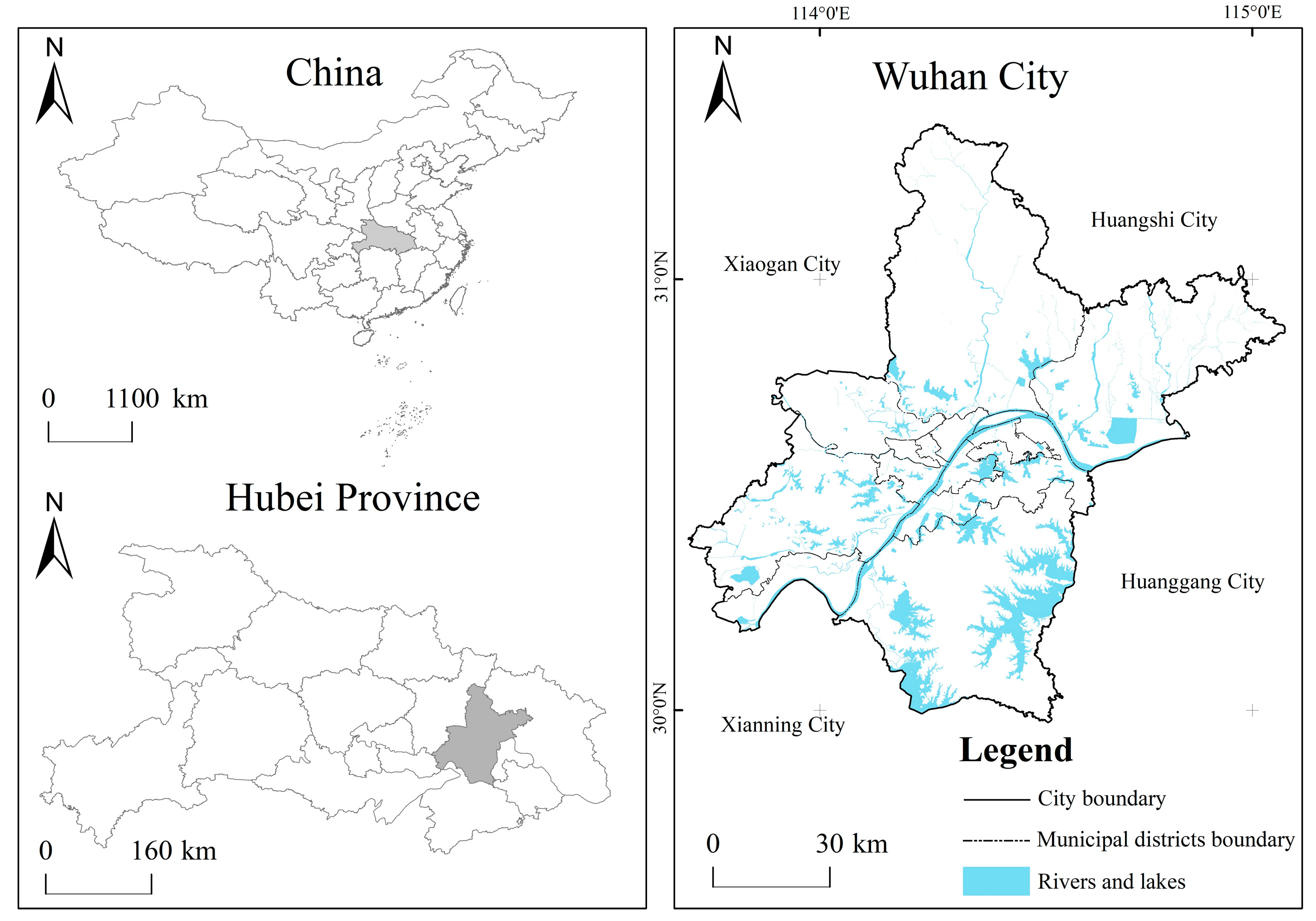
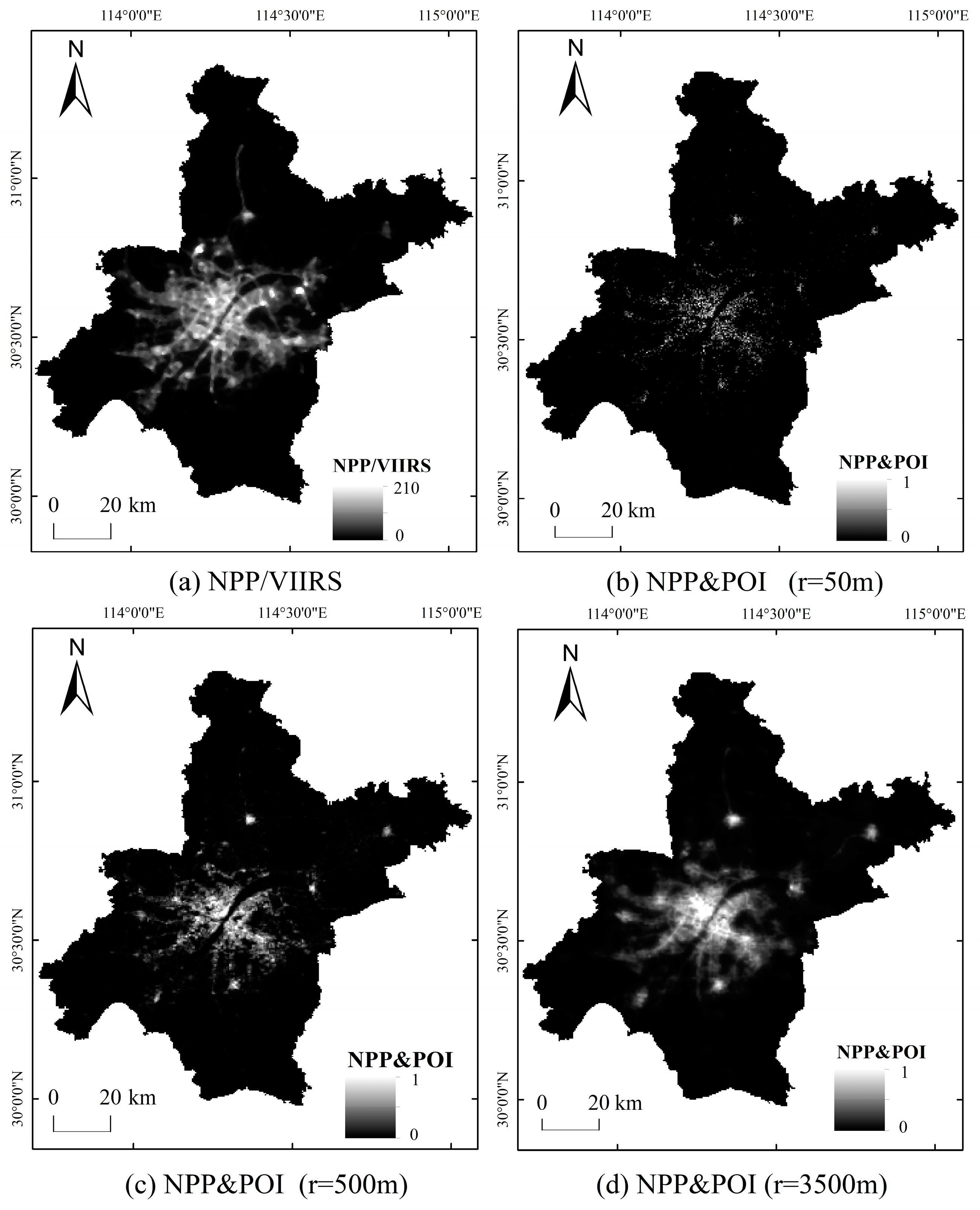





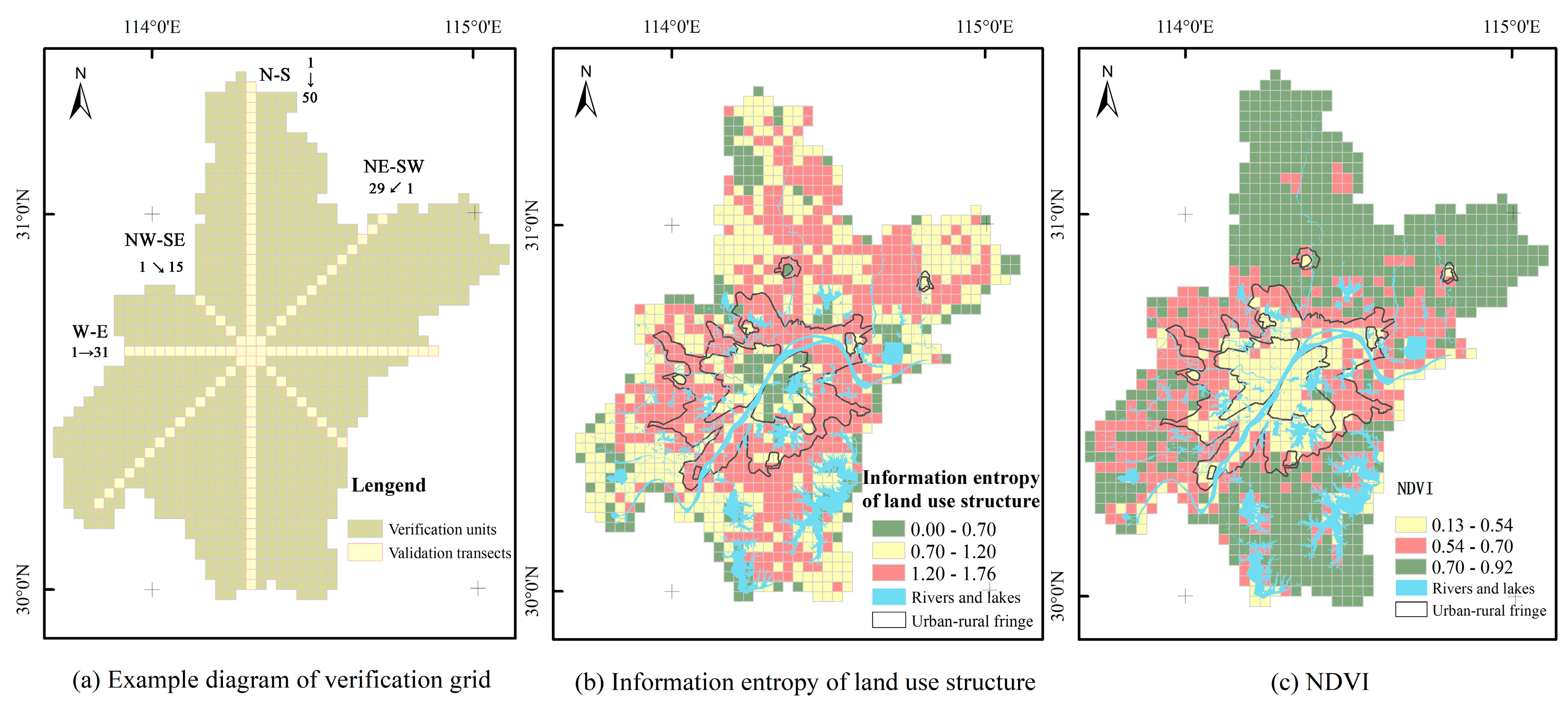
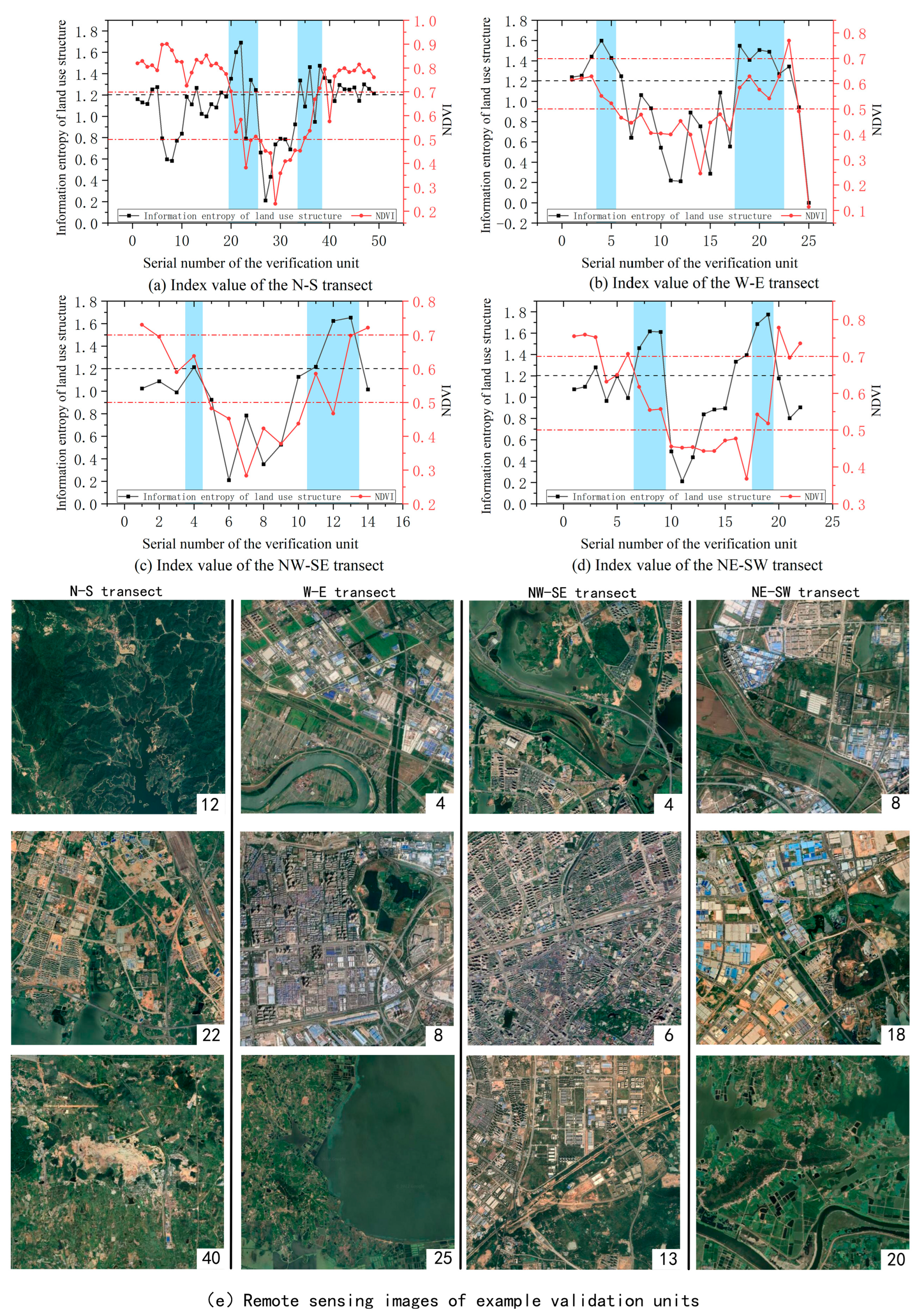
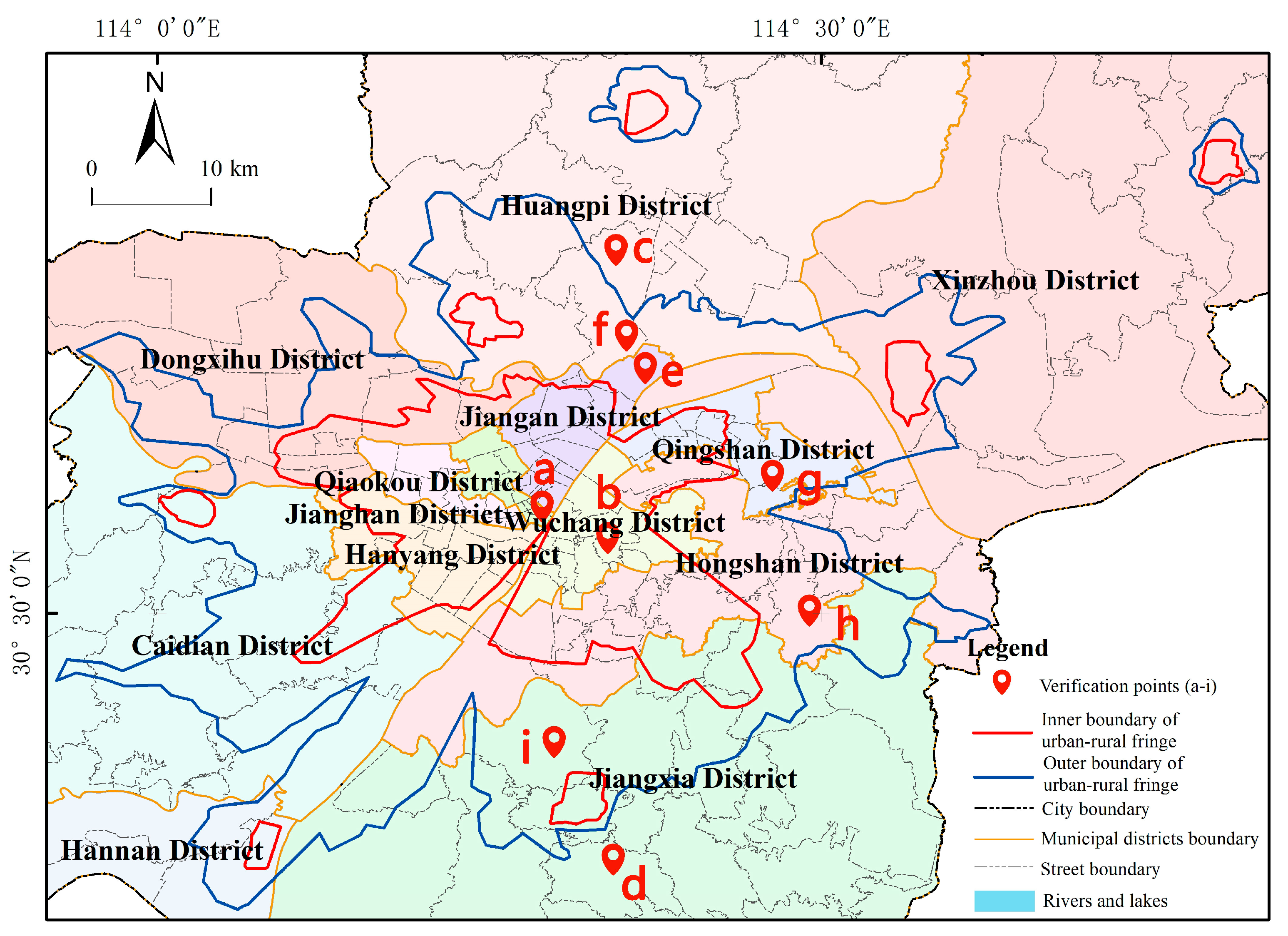
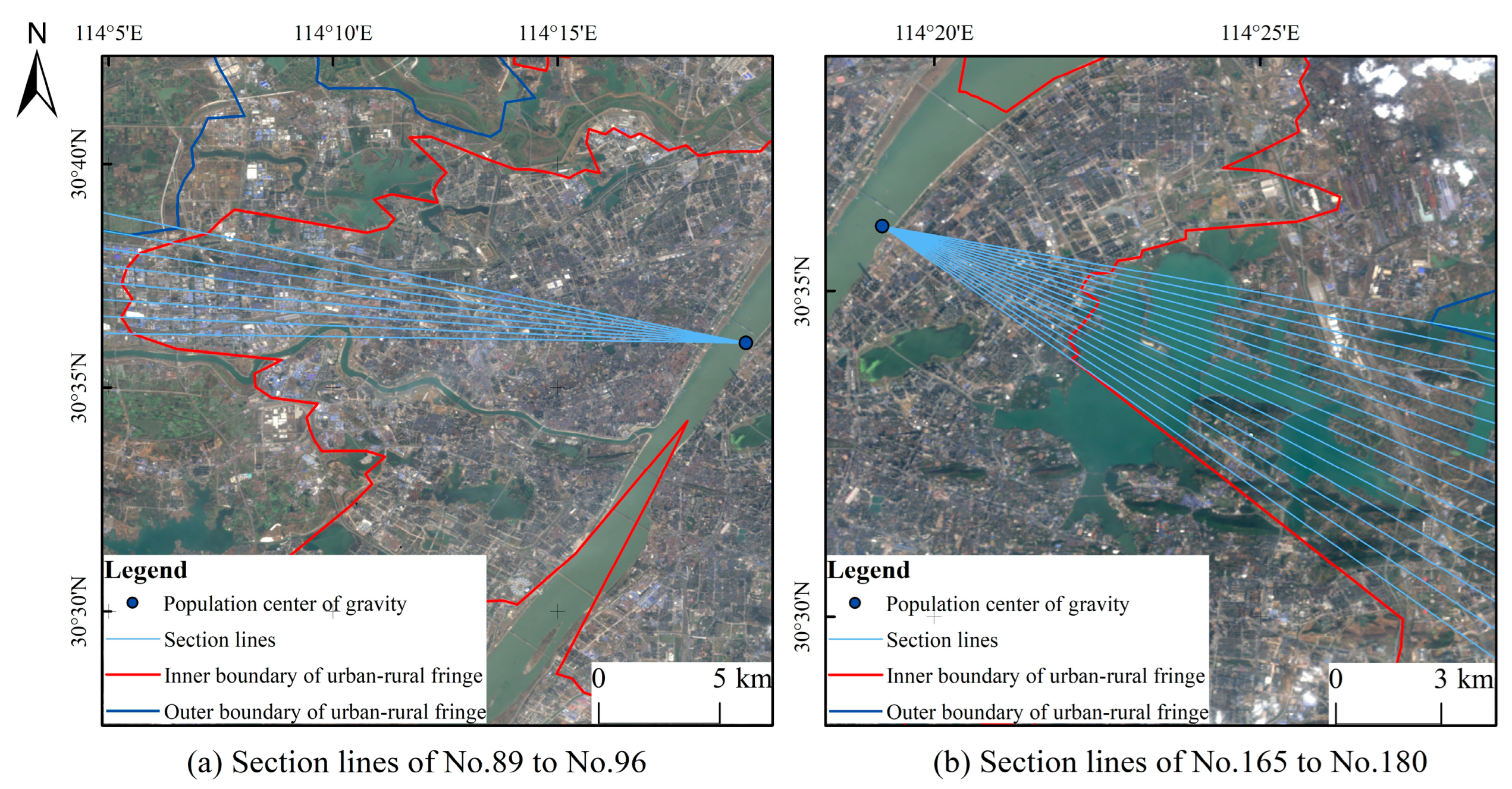
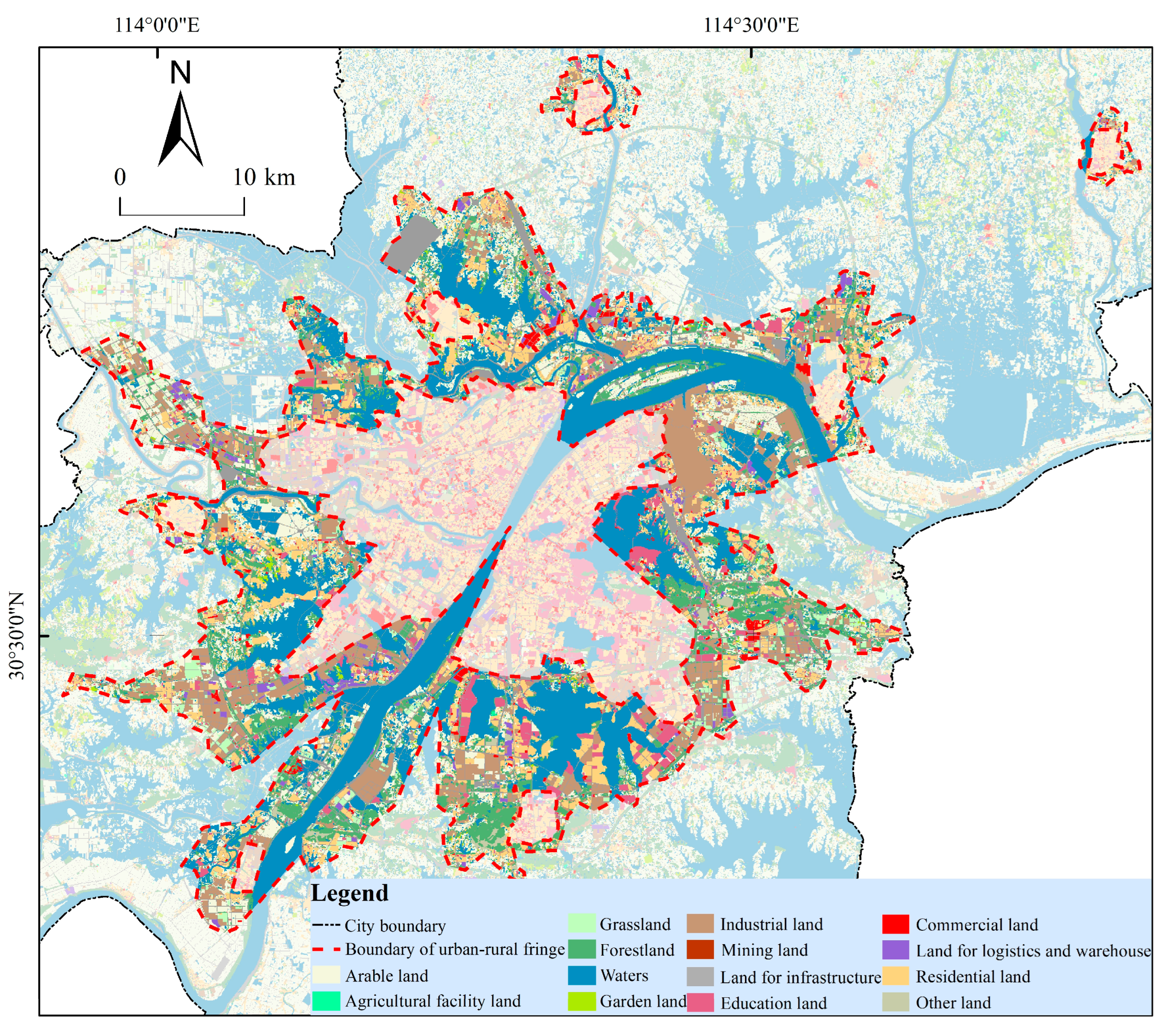
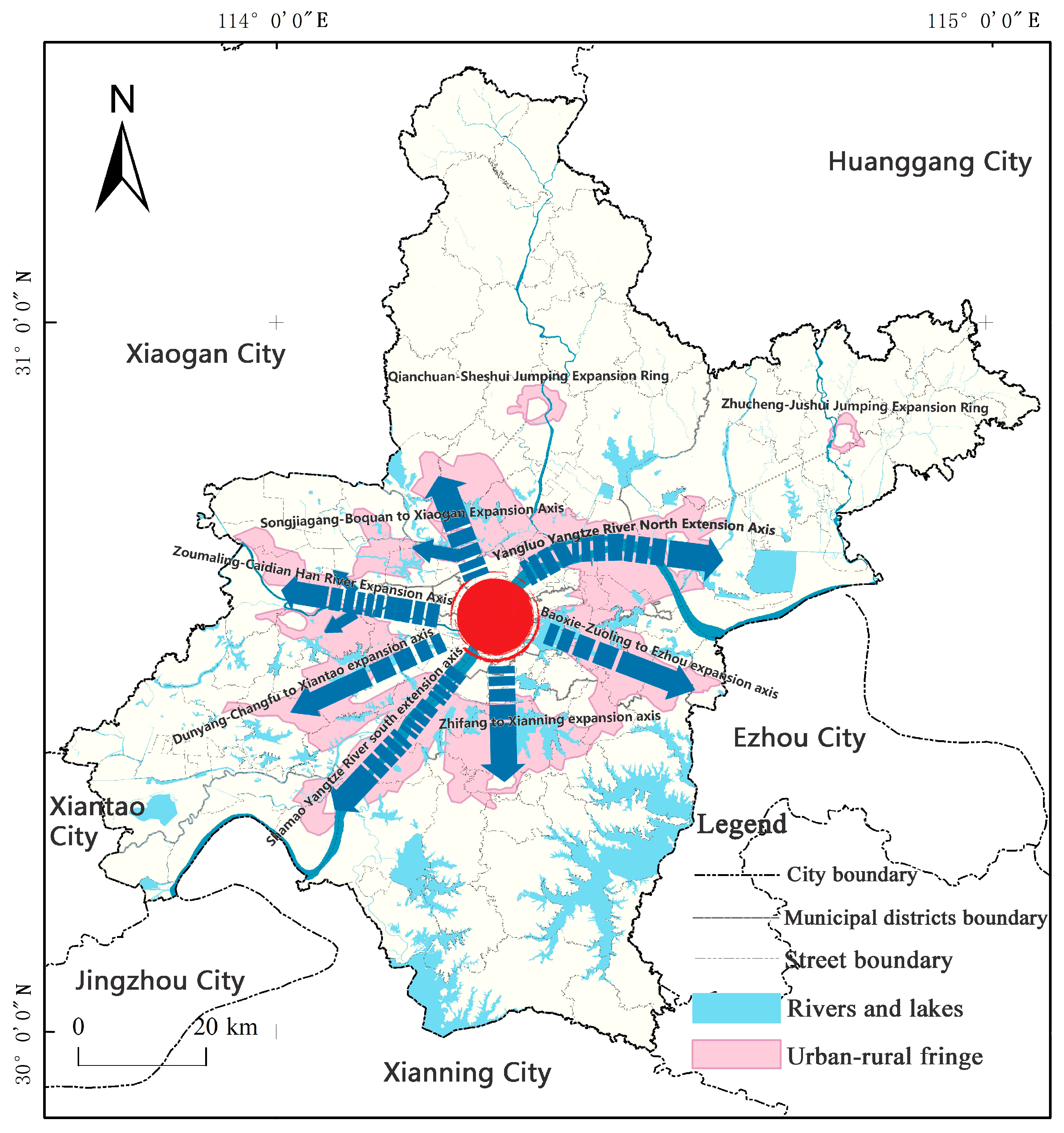

| POI Function Category | POI First Level Industry Classification in Baidu Map | Number of POIs |
|---|---|---|
| Cultural and Sports | Tourist attractions, leisure and entertainment, sports and fitness, education and training, cultural media, natural features | 53,966 |
| Commercial | Food, hotel, shopping, life service, beauty 1, car service, finance | 68,508 |
| Industrial | Corporate | 70,204 |
| Public service | Medical treatment, transportation facilities, government agencies | 33,640 |
| Residential | Real estate | 119,543 |
| Order Number of Section Lines | Average Value of Breaking Point of NPP and POI Composite Index |
|---|---|
| 1~30 | 0.109 |
| 31~60 | 0.095 |
| 61~90 | 0.105 |
| 91~120 | 0.103 |
| 121~150 | 0.097 |
| 151~180 | 0.114 |
| Land Category Name | Area/km2 | Proportion/% | |
|---|---|---|---|
| Agricultural land | Cultivated land | 216.42 | 14.60 |
| Agricultural facility land | 1.49 | 0.10 | |
| Sum | 217.91 | 14.70 | |
| Ecological land | Grassland | 34.51 | 2.33 |
| Forestland | 161.72 | 10.91 | |
| Waters | 445.15 | 30.03 | |
| Garden land | 5.58 | 0.37 | |
| Sum | 646.96 | 43.64 | |
| Construction land | Industrial land | 168.55 | 11.37 |
| Mining land | 5.41 | 0.36 | |
| Land for infrastructure | 175.11 | 11.81 | |
| Education land | 52.44 | 3.54 | |
| Commercial land | 20.54 | 1.39 | |
| Land for logistics and warehouse | 20.4 | 1.38 | |
| Residential land | 161.61 | 10.90 | |
| Sum | 604.06 | 40.75 | |
| Other lands | Other land | 13.42 | 0.91 |
| Sum | 13.42 | 0.91 | |
| Total | 1482.35 | 100 | |
Disclaimer/Publisher’s Note: The statements, opinions and data contained in all publications are solely those of the individual author(s) and contributor(s) and not of MDPI and/or the editor(s). MDPI and/or the editor(s) disclaim responsibility for any injury to people or property resulting from any ideas, methods, instructions or products referred to in the content. |
© 2023 by the authors. Licensee MDPI, Basel, Switzerland. This article is an open access article distributed under the terms and conditions of the Creative Commons Attribution (CC BY) license (https://creativecommons.org/licenses/by/4.0/).
Share and Cite
Yu, J.; Meng, Y.; Zhou, S.; Zeng, H.; Li, M.; Chen, Z.; Nie, Y. Research on Spatial Delineation Method of Urban-Rural Fringe Combining POI and Nighttime Light Data—Taking Wuhan City as an Example. Int. J. Environ. Res. Public Health 2023, 20, 4395. https://doi.org/10.3390/ijerph20054395
Yu J, Meng Y, Zhou S, Zeng H, Li M, Chen Z, Nie Y. Research on Spatial Delineation Method of Urban-Rural Fringe Combining POI and Nighttime Light Data—Taking Wuhan City as an Example. International Journal of Environmental Research and Public Health. 2023; 20(5):4395. https://doi.org/10.3390/ijerph20054395
Chicago/Turabian StyleYu, Jing, Yingying Meng, Size Zhou, Huaiwen Zeng, Ming Li, Zhaoxia Chen, and Yan Nie. 2023. "Research on Spatial Delineation Method of Urban-Rural Fringe Combining POI and Nighttime Light Data—Taking Wuhan City as an Example" International Journal of Environmental Research and Public Health 20, no. 5: 4395. https://doi.org/10.3390/ijerph20054395
APA StyleYu, J., Meng, Y., Zhou, S., Zeng, H., Li, M., Chen, Z., & Nie, Y. (2023). Research on Spatial Delineation Method of Urban-Rural Fringe Combining POI and Nighttime Light Data—Taking Wuhan City as an Example. International Journal of Environmental Research and Public Health, 20(5), 4395. https://doi.org/10.3390/ijerph20054395




